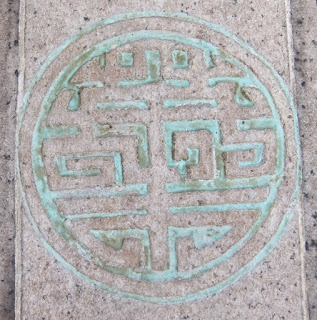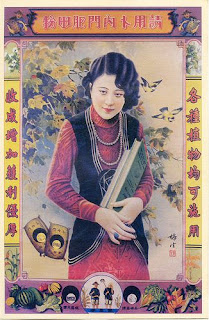A Chinese calligraphy in the block square seal style
Several posts ago we noted the central place of the octagon in Chinese design. (See here.) It was mentioned there, but only in passing, that the same geometrical figure occurs throughout Islamic designs. This current post explores the matter of common elements in Chinese/Islamic design more thoroughly based, once again, upon observations made during travels through the Sino-Asiatic world. The consonances, similarities and parallels between these two very different traditions only become obvious when you see them first-hand.
* * *
We tend to experience the world nowadays through abstract media – web logs included - rather than through concrete realities. A key component in this is the so-called ‘research’ undertaken by teams of academics in universities. The world has never been so ‘researched’ and the ‘research’ has never been so tainted by the zeitgeist of the era. The truth is that the world is being ‘researched’ to death. The stream of ‘research’ papers and books is unending, along with theories and counter-theories, and then documentaries and videos and conferences and lecture tours. Very little of it amounts to very much of substance. Most of it concerns ‘deconstructing’ a supposedly evil past. The present author grew weary of all of that and has set out instead upon a journey through two continents and a dozen countries, travelling cheap, leaving theories and conferences behind and observing, as they say, the ‘facts on the ground’, the smells and tastes and textures of the world. The abstractions of the academic life are nebulous and neurotic; there comes a time when it is necessary to put some concrete foundations under the castles in the air.
Certain things become plain when you see them in reality rather than through the medium of books or academic studies. Among the neo-orientalist preoccupations of the author is the historical and on-going encounter between the Mohammadans and the Chinese. This is one of the key themes of the second leg of his sojourn in Asia and accounts for his current trajectory – albeit gradual - overland towards the old silk road. First, though, he has spent time in the Prince of Wales Island, or Pe Nang, where the Malay Muslims live side by side with a very old and illustrious colony of Han Chinese. The two cultures overlap and sometimes clash, but generally they yield to a constructive co-existence. You can read about these Islamic/Chinese encounters, but to witness them first-hand brings an entirely different sense to them. Academic studies pose as objective, but it is an objectivity in service to certain agenda. It is good to put that aside and to see the realities from the street-level.
In this context, the author was able to see numerous examples of two calligraphic traditions – one Islamic and the other Chinese – that, very obviously, and regardless of what academic obfuscators might say, are related. He had read of such before in erudite studies, but encountering it first hand rendered the parallels plain and palpable. Academics quibble over the historical connections, and there is always some deconstructionist professor out to deny the obvious, but there can be little question that the two traditions have, at some point, cross-fertilized. On the one hand we have the so-called ‘Kufic’ style of Arabic calligraphy, named after the city of Kufa, a city at the far end of the silk road. And on the other we have Chinese calligraphies which have developed from the very ancient tradition of block seals by which the Chinese have long signed documents and other official accounts. Related to this, we can also observe the tradition of Islamic geometrical patterning on the one hand, and the tradition of Chinese geometrical screen patterns and latticework on the other. The same or a similar genius seems to work in each of these traditions, regardless of how remote they might be in time and space. They are related, and point to the common ground where the Mohammadan tradition and the Chinese tradition meet.
Some examples:
Here is a typical Kufic Arabic design:
The cursive exuberance of the Arabic script has been tamed and confined into geometrical shapes used to fill the rectilinear space. The very same design strategy is used in certain Chinese calligraphies, such as these which the author photographed at the Western & Oriental Hotel in George Town:
Here the Chinese characters for wisdom and wealth are stylized into a rectilinear geometry. The similarities with the Kufic style known to the Mohammadans should be plain. Some other examples from an old temple gate in George Town:
It is not until seeing these two traditions side by side in situ that their common foundations can be fully appreciated. The Mohammadan and Chinese universes are assuredly very different - the Malays and the Chinese are assuredly very different peoples with starkly different sociologies - and yet there is a deep substrata of common foundations. The present author knows of no academic studies that penetrate that substrata in any meaningful way.
The history that shaped this common foundation is uncertain, although it seems likely that the Chinese tradition was primary and the Arabic tradition derivative. The roots of Chinese block calligraphy are very ancient. The geometrical style developed from the need to adapt Chinese characters to block seals and stamps for official purposes:

It seems likely that this geometrical style of script then travelled the silk routes from the Far East into Mesopotamia where, for whatever reason, it found a home in the calligraphic schools of Kufa. That is, the Arabs learnt this style from the Chinese, just as they did such technologies as silk-making, with the silk road through Central Asia the connecting historical link. The extent of this debt to the Chinese, which is to say the extent to which Islam absorbed Chinese influences, is rarely appreciated. Academics in an age of deconstruction dwell on differences and downplay similarities. Yet the similarities are what are of interest here: not merely the fact of similar artistic conventions but, more importantly, similar mentalities and mind-sets. In both the Chinese and the Muslims we find a certain sense of the geometric, a Platonic sense of the geometric underpinnings of the dynamic cosmos. In both cases this is expressed via a sacred calligraphy in which world-as-text is implicit.
Below are some photographs of Chinese geometric seals from a temple in George Town:

Anyone familiar with classical Mohammadan design will see the similarity between these Chinese seals and corresponding designs found throughout the Middle East. But it is not just a matter of historical appropriation and 'influence' - quantifiable 'influences' are a matter of academic 'research'; it is more a matter of a common intellectual core, remarkable because to every outward appearance the Chinese and Mohammadan temperaments and world-views seem so very different or even at odds. At a certain level, then - quite aside from historical encounters on the silk road - the Chinese and Mohammadan traditions meet.
Regarding the broader question of the sense of the geometric and a shared mentality, consider also the tradition of Chinese lattice designs. Here again we are clearly in a similar intellectual domain to that which created the great heritage of Islamic geometric patterns.
Yours,
Harper McAlpine Black






















































